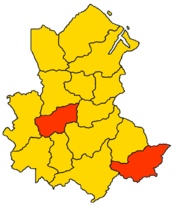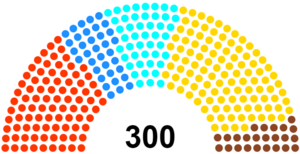1966 West Besmenian parliamentary election: Difference between revisions
Neuleinster (talk | contribs) No edit summary |
Neuleinster (talk | contribs) |
||
| (3 intermediate revisions by the same user not shown) | |||
| Line 7: | Line 7: | ||
| next_election = [[1968 Besmenian federal election| 1968 (reunited<br/> Besmenia)]] | | next_election = [[1968 Besmenian federal election| 1968 (reunited<br/> Besmenia)]] | ||
| elected_members = | | elected_members = | ||
| election_date = 11 October | | election_date = 11 October 1966 | ||
| seats_for_election = 300<!-- description --> | | seats_for_election = 300 seats in the National Assambly<!-- description --> | ||
| majority_seats = 151<!-- number --> | | majority_seats = 151<!-- number --> | ||
| turnout = | | turnout = | ||
| Line 54: | Line 54: | ||
| last_election5 = <!-- up to | last_election35 = --> | | last_election5 = <!-- up to | last_election35 = --> | ||
| results_sec = | | results_sec = | ||
| map = West Besmenia 1966 election map.png | | map = [[File:West Besmenia 1966 election map.png|177px]] | ||
| map_upright = | | map_upright = | ||
| map_alt = | | map_alt = | ||
| Line 75: | Line 75: | ||
==Election campaign and election programs== | ==Election campaign and election programs== | ||
The election campaign for the election was short and presented the parties with major organizational challenges, because these were only recently founded. In many places civil rights activists had enforced that offices were made available to them. Both the new groups and the parties experience in election campaigns. This gap was closed by massive engagement of the East Besmenian parties. All parties in East Besmenia supported their partner parties in West Besmenia to a large extent and were thus able to more than make up for the organizational lead of the BNU. Many East Besmenian politicans, like [[Albrecht | The election campaign for the election was short and presented the parties with major organizational challenges, because these were only recently founded. In many places civil rights activists had enforced that offices were made available to them. Both the new groups and the parties experience in election campaigns. This gap was closed by massive engagement of the East Besmenian parties. All parties in East Besmenia supported their partner parties in West Besmenia to a large extent and were thus able to more than make up for the organizational lead of the BNU. Many East Besmenian politicans, like [[Albrecht Nebeling]] or [[Helmut Glaubrecht]], took vacation to support their partner party in the West Besmenian election campaign. | ||
The decisive factor, however, was apparently not the strength of the organization, but the credibility in the promise of an approximation of economic conditions. While FBBP chairman [[Jürgen Rothmann]] was skeptical of a reunification, SDU chairman and prime minister [[Johannes Schmidt]] took the reunification offensive. | The decisive factor, however, was apparently not the strength of the organization, but the credibility in the promise of an approximation of economic conditions. While FBBP chairman [[Jürgen Rothmann]] was skeptical of a reunification, SDU chairman and prime minister [[Johannes Schmidt]] took the reunification offensive. | ||
Latest revision as of 22:15, 19 April 2024
| |||||||||||||||||||||||||||||||
300 seats in the National Assambly 151 seats needed for a majority | |||||||||||||||||||||||||||||||
|---|---|---|---|---|---|---|---|---|---|---|---|---|---|---|---|---|---|---|---|---|---|---|---|---|---|---|---|---|---|---|---|
This lists parties that won seats. See the complete results below. | |||||||||||||||||||||||||||||||
 Strongest party by district | |||||||||||||||||||||||||||||||
The 1966 West Besmenian parliamentary election was held on October 11, 1966 in the Besmenian Republic. It was the first free election in West Besmenia since 1923.
Background
After the West Besmenian Revolution and the victory of the revolutionaries, the democratization of West Besmenia began on June 9, 1966 after Rudolf Bötte (successor to Lars Schreim) proclaimed the Besmenian Republic. Later Bötte announced free elections for October 16th.
Election campaign and election programs
The election campaign for the election was short and presented the parties with major organizational challenges, because these were only recently founded. In many places civil rights activists had enforced that offices were made available to them. Both the new groups and the parties experience in election campaigns. This gap was closed by massive engagement of the East Besmenian parties. All parties in East Besmenia supported their partner parties in West Besmenia to a large extent and were thus able to more than make up for the organizational lead of the BNU. Many East Besmenian politicans, like Albrecht Nebeling or Helmut Glaubrecht, took vacation to support their partner party in the West Besmenian election campaign.
The decisive factor, however, was apparently not the strength of the organization, but the credibility in the promise of an approximation of economic conditions. While FBBP chairman Jürgen Rothmann was skeptical of a reunification, SDU chairman and prime minister Johannes Schmidt took the reunification offensive.
Results
| Party | Votes | % | Seats | |
|---|---|---|---|---|
| Conservative Union of Besmenia | 35,5 | 108 | ||
| Besmenian Socialist Party | 28,5 | 87 | ||
| Democratic Besmenia | 15,0 | 46 | ||
| New Besmenia | 11,4 | 35 | ||
| Besmenian National Union | 8,1 | 24 | ||
| Other parties | 1,3 | 0 | ||
| Invalid/blank votes | 0,2 | – | ||
| Total | 100 | 300 | ||
| Registered voters/turnout | 90,7 | – | ||
Aftermatch
After the election, the KUB and DB agreed on a joint coalition with Horst Lommberg as Chancellor and Erich Saalfeld as Vice Chancellor. The KUB-DB government started its work on November 8, 1966.
